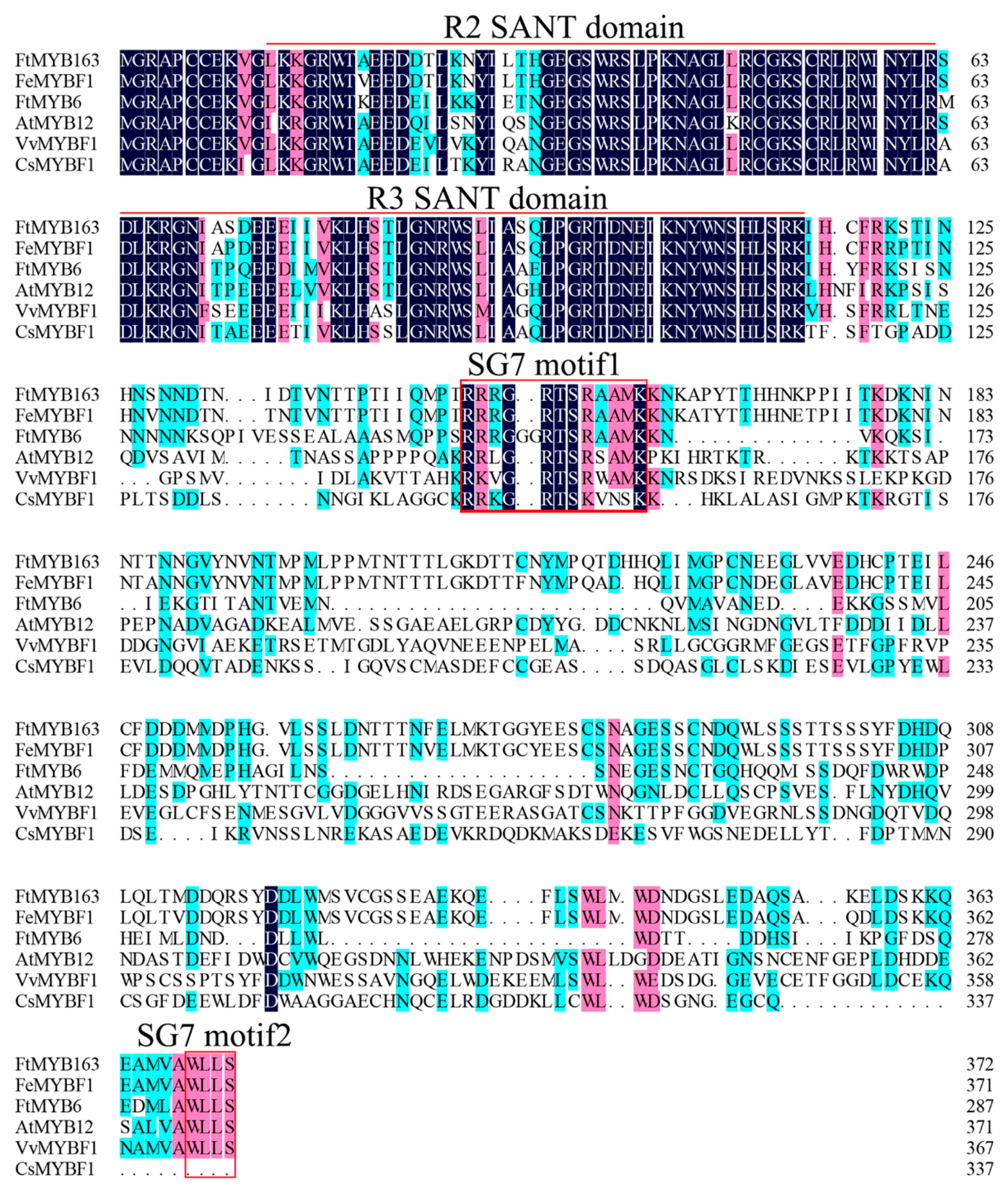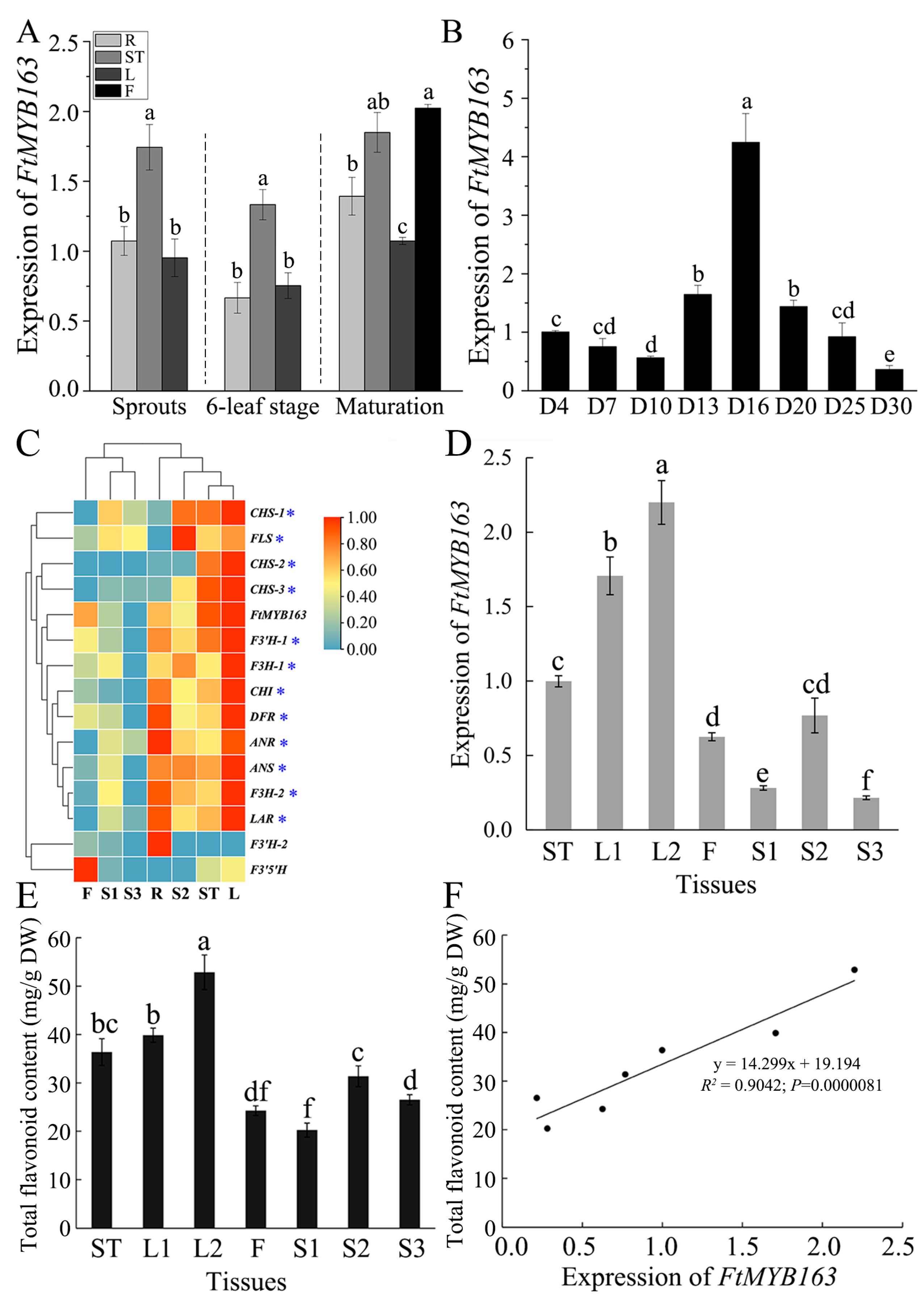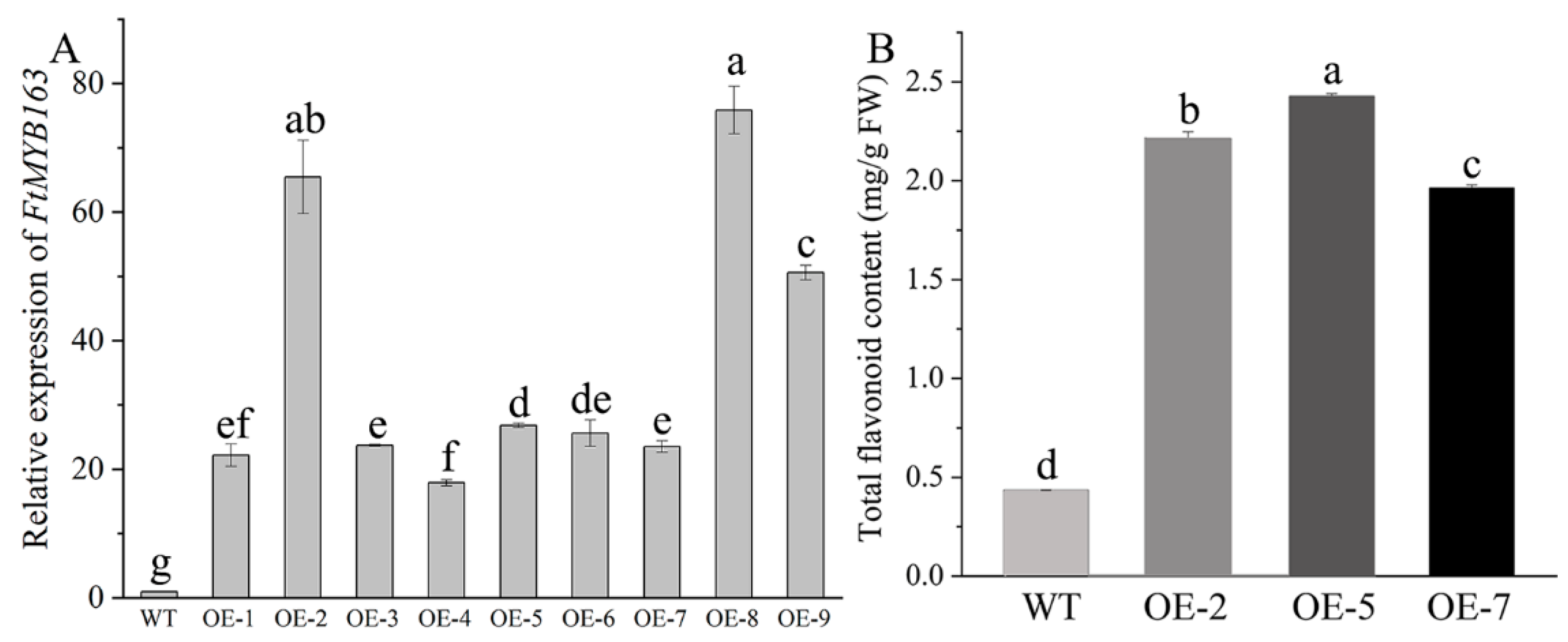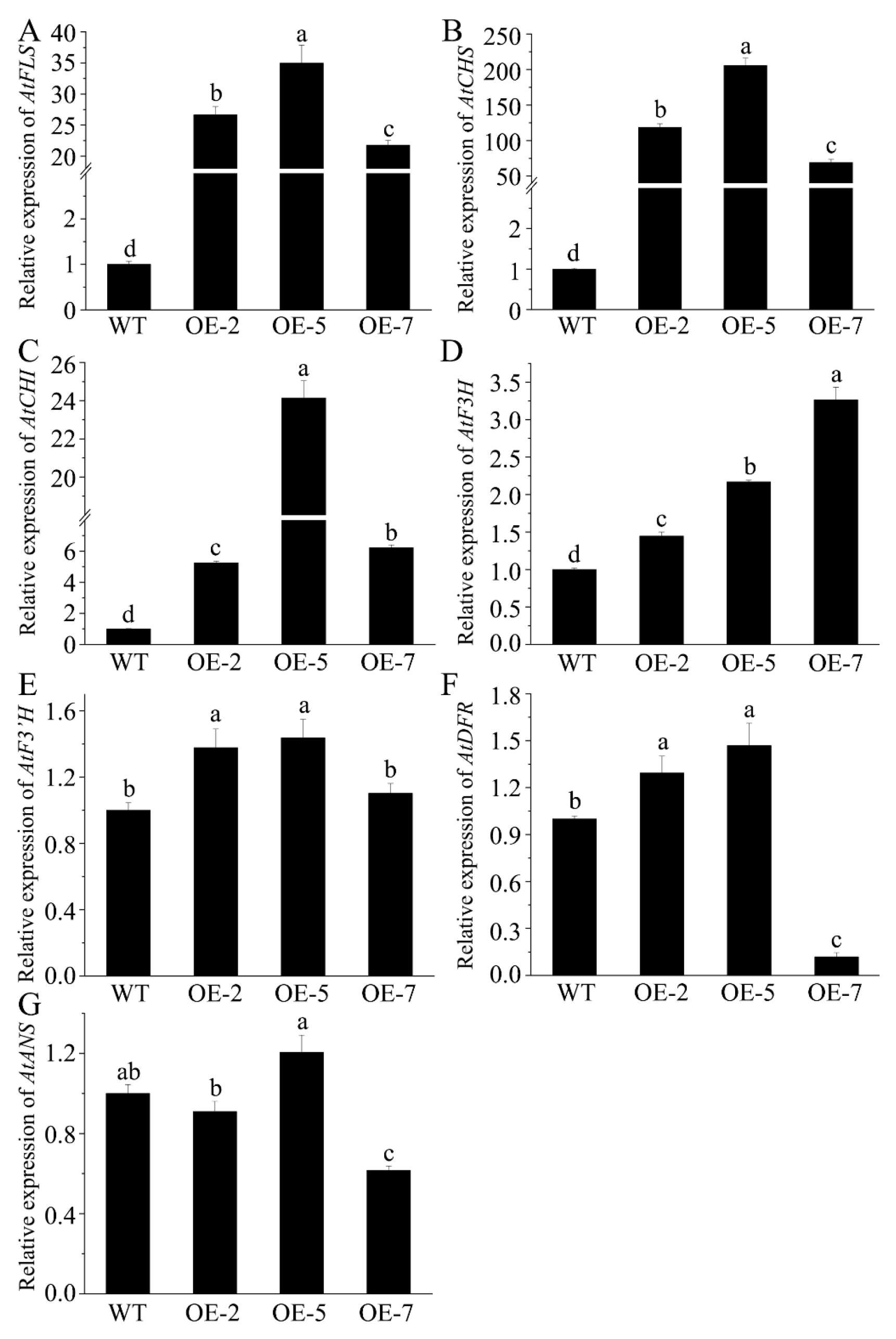FtMYB163 Gene Encodes SG7 R2R3-MYB Transcription Factor from Tartary Buckwheat (Fagopyrum tataricum Gaertn.) to Promote Flavonol Accumulation in Transgenic Arabidopsis thaliana
Abstract
:1. Introduction
2. Results
2.1. Cloning and Molecular Characteristics of FtMYB163
2.2. Subcellular Localization and Transcriptional Activity of FtMYB163
2.3. Comparing FtMYB163 Expression and Flavonoid Content in Tartary Buckwheat Tissues
2.4. Overexpression of FtMYB163 in Arabidopsis Increases Flavonoid Accumulation
2.5. Expression Analysis of Key Enzyme Genes of Flavonoid Synthesis
3. Discussion
4. Materials and Methods
4.1. Plant Materials and Culture Conditions
4.2. Gene Cloning and Sequencing
4.3. RNA Extraction and Gene Expression Analysis
4.4. Subcellular Localization
4.5. Transcriptional Activation of FtMYB163
4.6. Stable Transformation of Arabidopsis
4.7. Determination of the Flavonoid Content
4.8. Statistical Analysis and Reproducibility
5. Conclusions
Supplementary Materials
Author Contributions
Funding
Data Availability Statement
Conflicts of Interest
References
- Li, C.; Kobayashi, K.; Yoshida, Y.; Ohasawa, R. Genetic analyses of agronomic traits in Tartary buckwheat (Fagopyrum tataricum (L.) Gaertn.). Breed. Sci. 2012, 62, 303–309. [Google Scholar] [CrossRef] [PubMed]
- Wu, Q.; Bai, X.; Zhao, W.; Xiang, D.; Wan, Y.; Yan, J.; Zou, L.; Zhao, G. De dovo assembly and analysis of Tartary buckwheat (Fagopyrum tataricum Garetn.) transcriptome discloses key regulators involved in salt-stress response. Genes 2017, 8, 255. [Google Scholar] [CrossRef] [PubMed]
- Fabjan, N.; Rode, J.; Kosir, I.J.; Wang, Z.; Kreft, I. Tartary buckwheat (Fagopyrum tataricum Gaertn.) as a source of dietary rutin and quercitrin. J. Agric. Food Chem. 2003, 51, 6452–6455. [Google Scholar] [CrossRef] [PubMed]
- Zhao, Y.P.; Xiao, C.L. Determination of total flavones on Fagopyrum Gaertn of variety organs. Food Sci. 2004, 25, 264–266. (In Chinese) [Google Scholar]
- Qin, P.Y. Quality Evaluation of Chinese Main Buckwheat Cultivars and Effect of Processing on the Components and Health-Relevant Functionality of Buckwheat. Ph.D. Thesis, Chinese Academy of Agricultural Sciences, Beijing, China, 2012. [Google Scholar]
- Li, H.Y.; Lv, Q.Y.; Liu, A.K.; Wang, J.R.; Sun, X.Q.; Deng, J.; Chen, Q.F.; Wu, Q. Comparative metabolomics study of Tartary (Fagopyrum tataricum (L.) Gaertn) and common (Fagopyrum esculentum Moench) buckwheat seeds. Food Chem. 2022, 371, 131125. [Google Scholar] [CrossRef]
- Ke, J.; Ran, B.; Sun, P.Y.; Cheng, Y.Z.; Chen, Q.F.; Li, H.Y. An evaluation of the absolute content of flavonoids and the identification of their relationship with the flavonoid biosynthesis genes in Tartary buckwheat seeds. Agronomy 2023, 13, 3006. [Google Scholar] [CrossRef]
- Li, P.; Li, Y.J.; Zhang, F.J.; Zhang, G.Z.; Jiang, X.Y.; Yu, H.M.; Hou, B.K. The Arabidopsis UDP-glycosyltransferases UGT79B2 and UGT79B3, contribute to cold, salt and drought stress tolerance via modulating anthocyanin accumulation. Plant J. 2016, 89, 85–103. [Google Scholar] [CrossRef]
- Zhang, P.; Du, H.; Wang, J.; Pu, Y.; Yang, C.; Yan, R.; Yang, H.; Cheng, H.; Yu, D. Multiplex CRISPR/Cas9-mediated metabolic engineering increases soya bean isoflavone content and resistance to soya bean mosaic virus. Plant Biotechnol. J. 2019, 18, 1384–1395. [Google Scholar] [CrossRef]
- Saffer, A.M.; Irish, V.F. Flavonol rhamnosylation indirectly modifies the cell wall defects of RHAMNOSE BIOSYNTHESIS1 mutants by altering rhamnose flux. Plant J. 2018, 94, 649–660. [Google Scholar] [CrossRef] [PubMed]
- Tohge, T.; Fernie, A.R. Specialized metabolites of the flavonol class mediate root phototropism and growth. Mol. Plant 2016, 9, 1554–1555. [Google Scholar] [CrossRef]
- Tan, H.; Man, C.; Xie, Y.; Yan, J.; Chu, J.; Huang, J. A crucial role of GA-regulated flavonol biosynthesis in root growth of Arabidopsis. Mol. Plant 2019, 12, 521–537. [Google Scholar] [CrossRef] [PubMed]
- Lan, X.; Yang, J.; Abhinandan, K.; Nie, Y.; Li, X.; Li, Y.; Samuel, M.A. Flavonoids and ROS play opposing roles in mediating pollination in ornamental kale (Brassica oleracea var. acephala). Mol. Plant 2017, 10, 1361–1364. [Google Scholar] [CrossRef] [PubMed]
- Sharma, M.; Chai, C.L.; Morohashi, K.; Grotewold, E.; Snook, M.; Chopra, S. Expression of flavonoid 3’-hydroxylase is controlled by P1, the regulator of 3-deoxyflavonoid biosynthesis in maize. BMC Plant Biol. 2012, 12, 196. [Google Scholar] [CrossRef] [PubMed]
- Broun, P. Transcriptional control of flavonoid biosynthesis: A complex network of conserved regulators involved in multiple aspects of differentiation in Arabidopsis. Curr. Opin. Plant Biol. 2005, 8, 272–279. [Google Scholar] [CrossRef] [PubMed]
- Zheng, H.; Duan, B.; Yuan, B.; Chen, Z.; Yu, D.; Ke, L.; Zhou, W.; Liu, H.; Sun, Y. Flavanone and flavonoid hydroxylase genes regulate fiber color formation in naturally colored cotton. Crop J. 2023, 11, 766–773. [Google Scholar] [CrossRef]
- Bogs, J.; Ebadi, A.; McDavid, D.; Robinson, S.P. Identification of the flavonoid hydroxylases from grapevine and their regulation during fruit development. Plant Physiol. 2006, 140, 279–291. [Google Scholar] [CrossRef]
- Weerawanich, K.; Halbwirth, H.; Sirikantaramas, S. A novel MYB transcription factor from durian (Durio zibethinus), DzMYB1, regulates flavonoid biosynthesis in fruit pulp. Sci. Hortic. 2024, 333, 113246. [Google Scholar] [CrossRef]
- Tu, M.; Fang, J.; Zhao, R.; Liu, X.; Yin, W.; Wang, Y.; Wang, X.; Wang, X.; Fang, Y. CRISPR/Cas9-mediated mutagenesis of VvbZIP36 promotes anthocyanin accumulation in grapevine (Vitis vinifera). Hortic. Res. 2022, 1, 817–830. [Google Scholar] [CrossRef] [PubMed]
- Wang, N.; Liu, W.; Zhang, T.; Jiang, S.; Xu, H.; Wang, Y.; Zhang, Z.; Wang, C.; Chen, X. Transcriptomic analysis of red-fleshed apples reveals the novel role of MdWRKY11 in flavonoid and anthocyanin biosynthesis. J. Agric. Food Chem. 2018, 66, 7076–7086. [Google Scholar] [CrossRef]
- Ito, M. Conservation and diversification of three-repeat Myb transcription factors in plants. J. Plant Res. 2005, 118, 61–69. [Google Scholar] [CrossRef]
- Stracke, R.; Werber, M.; Weisshaar, B. The R2R3-MYB gene family in Arabidopsis thaliana. Curr. Opin. Plant Biol. 2001, 4, 447–456. [Google Scholar] [CrossRef] [PubMed]
- Dubos, C.; Stracke, R.; Grotewold, E.; Weisshaar, B.; Martin, C.; Lepiniec, L. MYB transcription factors in Arabidopsis. Trends Plant Sci. 2010, 15, 573–581. [Google Scholar] [CrossRef] [PubMed]
- Liu, Y.; Shi, Z.; Maximova, S.N.; Payne, M.J.; Guiltinan, M.J. Tc-MYBPA is an Arabidopsis TT2-like transcription factor and functions in the regulation of proanthocyanidin synthesis in Theobroma cacao. BMC Plant Biol. 2015, 15, 160. [Google Scholar] [CrossRef]
- Xu, W.; Dubos, C.; Lepiniec, L. Transcriptional control of flavonoid biosynthesis by MYB-bHLH-WDR complexes. Trends Plant Sci. 2015, 20, 176–185. [Google Scholar] [CrossRef] [PubMed]
- Nesi, N.; Jond, C.; Debeaujon, I.; Caboche, M.; Lepiniec, L. The Arabidopsis TT2 gene encodes and R2R3 MYB domain protein that acts as a key determinant for proanthocyanidin accumulation in developing seed. Plant Cell 2001, 13, 2099. [Google Scholar] [CrossRef] [PubMed]
- Luo, X.; Zhao, H.; Yao, P.; Li, Q.; Huang, Y.; Li, C.; Chen, H.; Wu, Q. An R2R3-MYB transcription factor FtMYB15 involved in the synthesis of anthocyanin and proanthocyanidins from Tartary buckwheat. J. Plant Growth Regul. 2017, 37, 76–84. [Google Scholar] [CrossRef]
- Wang, S.; Luo, X.P.; Yao, Y.J.; Yang, J.J.; Chen, Y.; Wu, Q.; Wu, Q. Characterization of an R2R3-MYB transcription factor involved in the synthesis of proanthocyanidins from Tartary buckwheat. Acta Bot. Boreali-Occident. Sin. 2019, 39, 1911–1918. (In Chinese) [Google Scholar]
- Yu, Y.; Liao, X.L.; Xiao, Y.H.; Zhao, H.X. Transcription factors gene FtMYB56 cloned from Fagopyrum tataricum, and its effects on flavonoid biosynthesis. Genom. Appl. Biol. 2020, 39, 4664–4671. (In Chinese) [Google Scholar]
- Sun, Z.; Linghu, B.; Hou, S.; Liu, R.; Wang, L.; Hao, Y.; Han, Y.; Zhou, M.; Liu, L.; Li, H. Tartary buckwheat FtMYB31 gene encoding an R2R3-MYB transcription factor enhances flavonoid accumulation in Tobacco. J. Plant Growth Regul. 2019, 39, 564–574. [Google Scholar] [CrossRef]
- Zhang, D.; Jiang, C.L.; Huang, C.H.; Wen, D.; Lu, J.N.; Chen, S.; Zhang, T.Y.; Shi, Y.H.; Xue, J.P.; Ma, W.; et al. The light-induced transcription factor FtMYB116 promotes accumulation of rutin in Fagopyrum tataricum. Plant Cell Environ. 2019, 42, 1240–1351. [Google Scholar] [CrossRef]
- Bai, Y.C.; Li, C.L.; Zhang, J.W.; Li, S.J.; Luo, X.P.; Yao, H.P.; Chen, H.; Zhao, H.X.; Park, S.U.; Wu, Q. Characterization of two tartary buckwheat R2R3-MYB transcription factors and their regulation of proanthocyanidin biosynthesis. Physiol. Plant 2014, 152, 431–440. [Google Scholar] [CrossRef] [PubMed]
- Zhang, Y.; Duan, J.J.; Wang, Q.Y.; Zhang, M.; Zhi, H.; Bai, Z.Z.; Zhang, Y.L.; Luo, J.R. The Paeonia qiui R2R3-MYB transcription factor PqMYBF1 positively regulates flavonol accumulation. Plants 2023, 12, 1427. [Google Scholar] [CrossRef]
- Li, H.; Lv, Q.; Ma, C.; Qu, J.; Cai, F.; Deng, J.; Huang, J.; Ran, P.; Shi, T.; Chen, Q. Metabolite profiling and transcriptome analyses provide insights into the flavonoid biosynthesis in the developing seed of Tartary buckwheat (Fagopyrum tataricum). J. Agric. Food Chem. 2019, 67, 11262–11276. [Google Scholar] [CrossRef] [PubMed]
- Yao, P.; Huang, Y.; Dong, Q.; Wan, M.; Wang, A.; Chen, Y.; Li, C.; Wu, Q.; Chen, H.; Zhao, H. FtMYB6, a light-induced SG7 R2R3-MYB transcription factor, promotes flavonol biosynthesis in Tartary buckwheat (Fagopyrum tataricum). J. Agric. Food Chem. 2020, 68, 13685–13696. [Google Scholar] [CrossRef] [PubMed]
- Zhang, L.; Li, X.; Ma, B.; Gao, Q.; Du, H.; Han, Y.; Li, Y.; Cao, Y.; Qi, M.; Zhu, Y.; et al. The Tartary buckwheat genome provides insights into rutin biosynthesis and abiotic stress tolerance. Mol. Plant 2017, 10, 1224–1237. [Google Scholar] [CrossRef] [PubMed]
- Matsui, K.; Oshima, Y.; Mitsuda, N.; Sakamoto, S.; Nishiba, Y.; Walker, A.R.; Ohme-Takagi, M.; Robinson, S.P.; Yasui, Y.; Mori, M.; et al. Buckwheat R2R3 MYB transcription factor FeMYBF1 regulates flavonol biosynthesis. Plant Sci. 2018, 274, 466–475. [Google Scholar] [CrossRef]
- Czemmel, S.; Stracke, R.; Weisshaar, B.; Cordon, N.; Harris, N.N.; Walker, A.R.; Robinson, S.P.; Bogs, J. The grapevine R2R3-MYB transcription factor VvMYBF1 regulates flavonol synthesis in developing grape berries. Plant Physiol. 2009, 151, 1513–1530. [Google Scholar] [CrossRef]
- Naik, J.; Rajput, R.; Pucker, B.; Stracke, R.; Pandey, A. The R2R3-MYB transcription factor MtMYB134 orchestrates flavonol biosynthesis in Medicago truncatula. Plant Mol. Biol. 2021, 106, 157–172. [Google Scholar] [CrossRef]
- Lin, S.; Singh, R.K.; Moehninsi; Navarre, D.A. R2R3-MYB transcription factors, StmiR858 and sucrose mediate potato flavonol biosynthesis. Hortic. Res. 2021, 8, 25. [Google Scholar] [CrossRef]
- Yang, F.; Wang, T.; Guo, Q.S.; Zou, Q.J.; Yu, S.Y. The CmMYB3 transcription factors isolated from the Chrysanthemum morifolium regulate flavonol biosynthesis in Arabidopsis thaliana. Plant Cell Rep. 2023, 42, 791–803. [Google Scholar] [CrossRef]
- Aharoni, A.; Vos, C.; Wein, M.; Sun, Z.; O’Connell, A.P. The strawberry FaMYB1 transcription factor suppresses anthocyanin and flavonol accumulation in transgenic tobacco. Plant J. 2001, 28, 319–332. [Google Scholar] [CrossRef]
- Davies, K.M.; Schwinn, K.E.; Deroles, S.C.; Manson, D.G.; Lewis, D.H.; Bloor, S.J.; Bradley, J.M. Enhancing anthocyanin production by altering competition for substrate between flavonol synthase and dihydroflavonol 4-reductase. Euphytica 2003, 131, 259–268. [Google Scholar] [CrossRef]
- Yao, P.F.; Li, C.L.; Zhao, X.R.; Li, M.F.; Zhao, H.X.; Guo, J.Y.; Cai, Y.; Chen, H.; Wu, Q. Overexpression of a Tartary buckwheat gene, FtbHLH3, enhances drought/oxidative stress tolerance in transgenic Arabidopsis. Front. Plant Sci. 2017, 8, 625. [Google Scholar] [CrossRef] [PubMed]
- Han, G.H.; Huang, R.N.; Hong, L.H.; Xu, J.X.; Hong, Y.G.; Wu, Y.H.; Chen, W.W. The transcription factor NAC102 confers cadmium tolerance by regulating WAKL11 expression and cell wall pectin metabolism in Arabidopsis. J. Integr. Plant Biol. 2023, 65, 2262–2278. [Google Scholar] [CrossRef] [PubMed]
- Livak, K.J.; Schmittgen, T.D. Analysis of relative gene expression data using real-time quantitative PCR and the 2−ΔΔCT method. Methods 2001, 25, 402–408. [Google Scholar] [CrossRef]
- Maron, L.G.; Piñeros, M.A.; Guimarães, C.T.; Magalhaes, J.V.; Pleiman, J.K.; Mao, C.; Shaff, J.; Belicuas, S.N.J.; Kochian, L.V. Two functionally distinct members of the MATE (multi-drug and toxic compound extrusion) family of transporters potentially underlie two major aluminum tolerance QTLs in maize. Plant J. 2010, 61, 728–740. [Google Scholar] [CrossRef]
- Colugh, S.J.; Bent, A.F. Floral dip: A simplifed method for Agrobacterium-mediated transformation of Arabidopsis thaliana. Plant J. Cell. Mol. Biol. 1998, 16, 735. [Google Scholar]






| No. | Class | Compounds | WT | OE-2 | OE-5 | OE-7 |
|---|---|---|---|---|---|---|
| 1 | Chalcone | Trilobatin | 1 ± 0.1 c | 5.4 ± 0.1 b | 7.8 ± 1.1 a | 2.7 ± 0.2 c |
| 2 | Chalcone | Naringenin chalcone | 1 ± 0.2 b | 84.8 ± 9.9 a | 84.3 ± 15.5 a | 25.1 ± 2.0 b |
| 3 | Dihydroflavone | Hesperidin | 1 ± 0.1 b | 11.7 ± 2.7 a | 15.4 ± 0.2 a | 14.8 ± 0.1 a |
| 4 | Dihydroflavone | Eriocitrin | 1 ± 0.2 b | 39.8 ± 7.9 a | 37.7 ± 2.0 a | 16.3 ± 2.6 b |
| 5 | Dihydroflavone glycoside | Naringenin-7-O-glucoside | 1 ± 0.0 b | 246.3 ± 20.1 a | 256.4 ± 50.3 a | 61.8 ± 7.6 b |
| 6 | Dihydroflavone | Eriodictyol | 1 ± 0.1 b | 134.4 ± 27.7 a | 157.5 ± 43.5 a | 14.6 ± 4.3 b |
| 7 | Dihydroflavonol | Dihydrokaempferol | 1 ± 0.2 b | 3.9 ± 1.2 ab | 6.2 ± 2.1 a | 1.3 ± 0.1 b |
| 8 | Dihydroflavonol | Taxifolin 7-O-rhamnoside | 1 ± 0.1 c | 30.1 ± 4.2 a | 26.2 ± 1.1 a | 14.2 ± 1.3 b |
| 9 | Flavone | Luteolin-7-glucoside | 1 ± 0.0 b | 13.1 ± 13.1 a | 4.5 ± 0.3 ab | 4.2 ± 2.1 ab |
| 10 | Flavone | Apigenin 7-glucoside | 1 ± 0.1 b | 37.7 ± 4.7 a | 39.5 ± 4.5 a | 14.6 ± 2.3 b |
| 11 | Flavonol | Afzelin/kaempferol-3-rhamnoside | 1 ± 0.0 c | 3.0 ± 0.2 b | 9.0 ± 0.1 a | 1.5 ± 0.1 c |
| 12 | Flavonol | Isorhamnetin-3-O-glucoside | 1 ± 0.2 b | 19.0 ± 0.0 b | 71.2 ± 14.5 a | 4.6 ± 1.6 b |
| 13 | Flavonol | Astragalin/kaempferol-3-glucoside | 1 ± 0.0 b | 1.6 ± 0.0 b | 5.5 ± 0.3 a | 1.2 ± 0.2 b |
| 14 | Flavonol | Quercitrin/Quercetin 3-rhamnoside | 1 ± 0.0 c | 2.5 ± 0.4 b | 8.5 ± 0.1 a | 1.2 ± 0.1 c |
| 15 | Flavonol | Baimaside | 1 ± 0.3 b | 3.5 ± 0.3 ab | 6.2 ± 2.0 a | 2.8 ± 0.3 ab |
| 16 | Flavonol | Avicularin/Quercetin 3-alpha-L-arabinofuranoside | 1 ± 0.0 b | 2.1 ± 0.1 b | 12.6 ± 0.8 a | 1.3 ± 0.2 b |
| 17 | Flavonol | Quercetin | 1 ± 0.2 b | 7.0 ± 3.1 b | 55.5 ± 5.1 a | 1.9 ± 0.0 b |
| 18 | Flavonol | Kaempferol | 1 ± 0.4 b | 28.3 ± 4.1 a | 42.6 ± 7.5 a | 2.2 ± 0.3 b |
Disclaimer/Publisher’s Note: The statements, opinions and data contained in all publications are solely those of the individual author(s) and contributor(s) and not of MDPI and/or the editor(s). MDPI and/or the editor(s) disclaim responsibility for any injury to people or property resulting from any ideas, methods, instructions or products referred to in the content. |
© 2024 by the authors. Licensee MDPI, Basel, Switzerland. This article is an open access article distributed under the terms and conditions of the Creative Commons Attribution (CC BY) license (https://creativecommons.org/licenses/by/4.0/).
Share and Cite
Du, H.; Ke, J.; Sun, X.; Tan, L.; Yu, Q.; Wei, C.; Ryan, P.R.; Wang, A.; Li, H. FtMYB163 Gene Encodes SG7 R2R3-MYB Transcription Factor from Tartary Buckwheat (Fagopyrum tataricum Gaertn.) to Promote Flavonol Accumulation in Transgenic Arabidopsis thaliana. Plants 2024, 13, 2704. https://doi.org/10.3390/plants13192704
Du H, Ke J, Sun X, Tan L, Yu Q, Wei C, Ryan PR, Wang A, Li H. FtMYB163 Gene Encodes SG7 R2R3-MYB Transcription Factor from Tartary Buckwheat (Fagopyrum tataricum Gaertn.) to Promote Flavonol Accumulation in Transgenic Arabidopsis thaliana. Plants. 2024; 13(19):2704. https://doi.org/10.3390/plants13192704
Chicago/Turabian StyleDu, Hanmei, Jin Ke, Xiaoqian Sun, Lu Tan, Qiuzhu Yu, Changhe Wei, Peter R. Ryan, An’hu Wang, and Hongyou Li. 2024. "FtMYB163 Gene Encodes SG7 R2R3-MYB Transcription Factor from Tartary Buckwheat (Fagopyrum tataricum Gaertn.) to Promote Flavonol Accumulation in Transgenic Arabidopsis thaliana" Plants 13, no. 19: 2704. https://doi.org/10.3390/plants13192704






